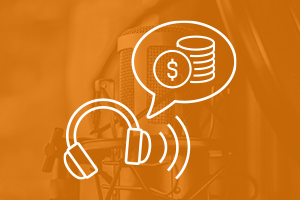How to Determine the ROI of Your Podcast

Creating a podcast requires quite a bit of time and effort on your part. You can probably quantify how much time you spent writing, researching, recording and editing. And, if you love the result of your hard work, then your investment was certainly worth your time.
However, you might want to take your insights a step further and figure out the return on investment, or ROI, you receive from recording your podcast each day, week or month. Everyone’s definition of ROI will be different, of course – while some podcasts aim to boost brand awareness, others exist to inspire engagement, relationships or referrals.
Because everyone’s goals will be different, there’s not a single way to quantify the ROI of a podcast. Here are six different methods to consider:
- Number of Listeners or Downloads
- Reviews
- Repurposing Content
- Email Click-Throughs
- Ad Revenue or Sponsorships
1. Number of Listeners or Downloads
This measure is probably the most common way of determining a podcast’s relative success. With lots of listeners comes advertisements and revenue from that, as well as extended reach and engagement with your brand and any calls to action you make. Those behind the best marketing podcasts probably know this to be true.
But your total number of listeners doesn’t necessarily reflect success, especially if you create a podcast with a niche focus. You’ll undoubtedly have a smaller set of listeners, but that number could still mean your work has been worth the time you invested.
2. Reviews
The public opinion of your podcast can also influence what you determine to be your ROI – the more five-star ratings, the better. Again, the total number of downloads or listens might not be as high as other podcasts out there, but knowing listeners have enjoyed what you do could be a marker for success.
For the podcast Serial, for example, its ratings wavered from the first season to the second – during the latter portion of the show, some listeners thought it hit a lull and ranked it as such. Now, though, the third season brought the show back, and some argue it’s even better this time. So, the high ratings poured back in, likely a sign of ROI to the Serial team.
3. Repurposing Content
Not all podcasters work in the podcasting medium alone. Instead, many will find multiple ways to reuse the content they create for the platform. For instance, a single episode could be re-cut into video content, tweets and other social media posts, blogs, etc.
The Proactive Worldwide Business Intelligence Podcast finds ways to re-purpose their content well. Along with their weekly podcasts, they have a corresponding blog that listeners can cross-reference. Plus, they share non-podcast-related posts that would interest those who end up on the site because of the podcast, thus keeping them around and sating their need for more information.
4. Email Click-Throughs
Some content creators use clicks as a judge of their popularity and success. They send emails that tout a new podcast episode, and then they see who clicks through to listen or download. It most cases, it would be engaged listeners who would do so – they value what they’re hearing, and they want to tune in for more. Plus, these emails can provide some insight into what content gets your audience excited enough to click through and hear more, so you can tailor your topics of conversation to what your listeners like.
5. Ad Revenue or Sponsorships
You might consider your podcast to be a success once you rope in advertisers or sponsors. Indeed, this is a great way to make money and a traditional return on investment. Typically, you would subtract the amount of money you spent to make your series, from the amount you receive in ad revenue. If the resulting number is positive, then you’ll know you made an ROI.
You’ve probably heard podcasts with ads. The Dream, one of 2018’s most popular podcasts, covered the ins and outs of multi-level marketing schemes. Between each episode, listeners heard commercials from a variety of brands advertising through this medium. This partnership helped The Dream make money on its production.
Of course, ad revenue can be a double-edged sword. It’s great for your podcast, obviously, but many listeners detest the ads in the middle of their listening. So, if you choose this as your gauge for ROI, remember that it might come at a cost with your fan base.
6. Professional Relationships and Networking
Podcasting allows you to meet lots of new people. Perhaps you hired a staff to help you produce your show, or you enlisted the help of a respected industry professional to advise you in your quest. Some podcasters get to interview people who they’d never speak to otherwise, or to ask questions they might not ever get to cover. For instance, The Griefcast invites comedians to talk about their loss of a loved one. The show aims to shed light on our hard times – a standard interviewer probably wouldn’t broach the topic.
The right guests can also boost your show’s standing with listeners. And the right guests can connect you with other potential interviewees, who will continue the referral process and further boost your reputation and success. These relationships could be enough to validate your hard work, too.
Determine Your ROI
Not every podcast’s worth can be determined by the number of listeners or the amount of ad revenue it draws in. So, figure out where the value of your production lies, then quantify that area as best you can – the above six are only a few examples of how to do it.
Most importantly, though, if you find joy and fulfillment in making your podcast, then you already calculated at least part of your ROI, because that’s what it’s all about.


